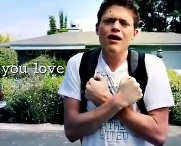Incorporating ASL Music Videos in an Accessible Multimodal Pedagogy
Analyzing ASL Music Videos
We can introduce students to ASL music videos with the purpose of asking them to analyze accessible multimodal compositions. I have asked different first-year composition students to analyze how the dynamic visual text of a music video orchestrates with the action on screen to represent the message of the song and make lyrical meaning accessible for audiences.
I here abridge an assignment prompt asking students to analyze accessible multimodal compositions. This prompt can be redesigned and expanded for incorporation in different learning spaces.
Prompt for Analyzing ASL Music Videos
For this assignment, choose a music video with dynamic visual text. Analyze the rhetorical strategies that are at work in the design of the music video. Specifically, analyze how the dynamic visual text works to convey the meaning of the song.
Use your analytical skills to examine the ways in which text (the words), visuals (the images), and sound work together to convey the message of the music video to its audience. As part of your analysis, refer specifically to moments in the video (with timestamps). Describe how the performers in the video, the dynamic visual text, and the sound of the music combine to reach the audience. Give specific examples from the video to analyze the rhetorical strategies.
Your goal in this paper is to explain how your chosen music video with dynamic visual text makes meaning accessible across multiple modes (the mode of sound, the mode of the written word, and so forth) and ways of communication.
Students will likely find a range of relatively accessible multimodal compositions in response to this project. And each video, or composition, will be quite different in how accessible or inaccessible the message is for audiences. These differences allow for students to analyze their videos in their own ways. Students in my class have approached the rhetorical analysis of their videos in various ways: from focusing on how the visual effects of a music video reflect the movement of dancing bodies to the ways that the color scheme enhances the mood of the song. The strongest analyses describe how and why the different layers of the video work together to capture the lyrical (and rhetorical) message. They show that the visual text is an essential design element of the video that makes the video more accessible to audiences.
Designing Accessible Multimodal Compositions
To support the development of students' analytical skills, I have asked them to design their own videos with dynamic visual text. (Naturally, I wouldn’t ask them to create ASL videos!). Although I have placed “Designing” after “Analyzing” here, I find that the two are complementary: analyzing accessible music videos can help students design their own compositions just as designing accessible videos can help students analyze other compositions. After working to change the color of words to reflect changes in their message (the design process), students might be more open to realizing that a music video uses color to convey changes in mood (the analysis process).
I have found that asking students to design their own videos gives them the space to become creators who need to consider different ways to reach their audiences. As they work through the process, and frustrations, of designing and creating accessible videos, they develop a better understanding of how dynamic visual text can convey the rhetorical message of their videos. Experiencing the composing process opens up some insight into how and why the changes in size, placement, and color of visual text embody meaning.
When reflecting on their designs for their own videos, students have indicated that they realize the importance of making visual text reflect the sounds and message of a video. They have thoughtfully described the rhetorical and aesthetic choices they made in changing visual text to emphasize, reflect, or symbolize the changes in their message throughout the video. They have noticed how their classmates used different techniques to reach to different audiences—from using whimsical text for children’s stories to cursive, pink font for young women.
Regardless of the quality of their videos, the efforts they put in designing accessible videos reflects an awareness of making rhetorical messages apparent. The rhetorical skills and clearer perspective they develop in the designing process have guided them through analyzing other videos.
I here provide a sample prompt that asks students to design their own accessible multimodal compositions.
Prompt for Designing Accessible Multimodal Compositions
We have analyzed the rhetorical and visual design of dynamic visual text in several class activities. You are also analyzing the rhetorical strategies used by dynamic visual text in music videos. Now it’s your turn! Form groups and create your own brief and accessible video.
Here’s what you can do:
- Record a video with a clear purpose and audience. You can use your phone, the webcam on your laptop/tablet, or another device to record a video. This video can be anything you wish (within reason!).
- Discuss rhetorical strategies for conveying the meaning/purpose of your video to your audience. Think about how you can make the meaning accessible to your audience.
- Add dynamic visual text using video editing software.
- Share your video with the class. We will view and discuss each other’s videos in class.
I have not graded students based on the quality of their videos, but on their reflections on the process itself. I value the self-assessments and self-discoveries that students make about and through the composing, analyzing, and designing processes—and that takes us to “Reflecting.”
NEXT: Pedagogy 3: Reflecting on ASL Music Videos and Redesigning Accessible Multimodal Compositions
